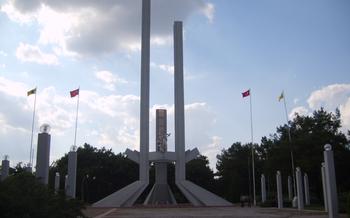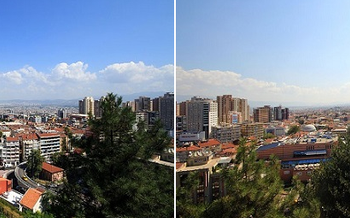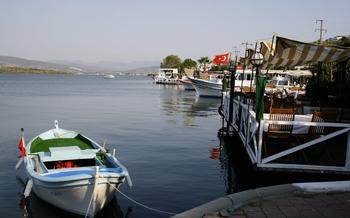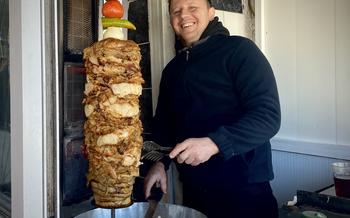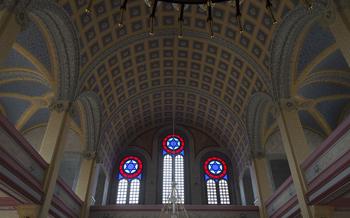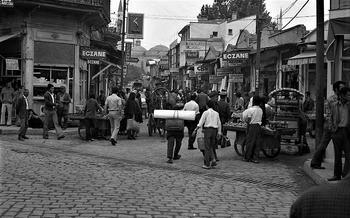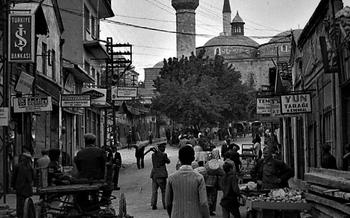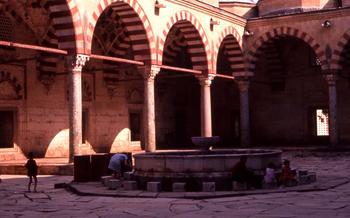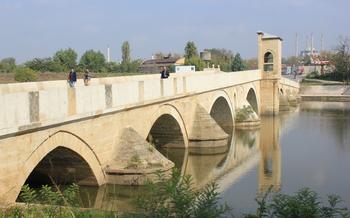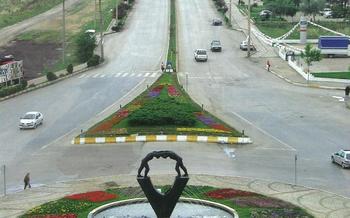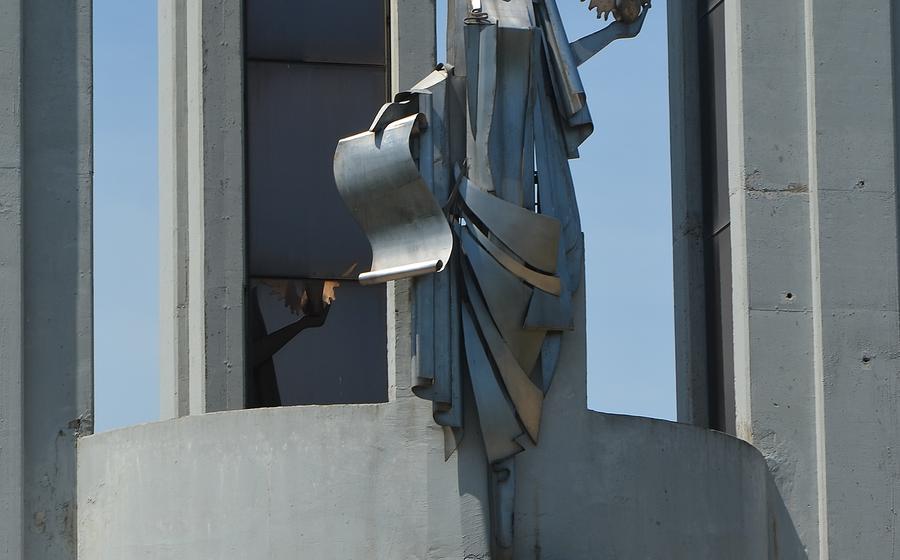
Treaty of Lausanne Monument and Museum
- A Monument to Diplomacy and Friendship:
- Witnessing History at the Treaty of Lausanne Museum
- Admission Information
- Architectural Marvel
- Immersive Experience
- Historical Insights
- Symbol of Peace
- Educational Resource
- Cultural Significance
- Photography and Social Media
- Local Cuisine
- Souvenirs and Gifts
- Nearby Attractions
- Insider Tip: Uncover the Secrets of the Hidden Garden
A Monument to Diplomacy and Friendship:
The Treaty of Lausanne Monument in Edirne stands as a testament to the enduring peace and friendship between Turkey and Greece. Signed in 1923, the Treaty of Lausanne marked a turning point in the history of the two nations, bringing an end to the bitter Greco-Turkish War and establishing new borders. The treaty's key provisions included the exchange of populations, with over 5 million Greeks and Turks forced to leave their homes, a decision that had profound and lasting consequences. The monument serves as a poignant reminder of this tumultuous period and the challenges faced in forging a new era of cooperation and understanding.
Witnessing History at the Treaty of Lausanne Museum
Housed within the walls of the Treaty of Lausanne Monument stands the Treaty of Lausanne Museum, a treasure trove of historical artifacts and interactive exhibits that bring to life the events and negotiations surrounding the pivotal treaty. As visitors step through the museum's doors, they embark on a journey through time, immersing themselves in the intricate details of this landmark agreement.
The museum's exhibits showcase a diverse collection of documents, photographs, and personal belongings that belonged to the key architects of the treaty, including İsmet İnönü and Eleftherios Venizelos. These artifacts offer a glimpse into the lives and contributions of the individuals who shaped the course of history.
Interactive displays engage visitors in a dynamic experience, allowing them to explore the complexities of the negotiations and the challenges faced by both sides. Multimedia presentations bring to life the historical context, providing a deeper understanding of the events leading up to the signing of the treaty.
Through its immersive exhibits and educational displays, the Treaty of Lausanne Museum serves as a vital repository of knowledge, preserving the memory of this pivotal historical event and promoting a greater understanding of its enduring legacy.
Admission Information
The Treaty of Lausanne Monument and Museum adheres to specific hours of operation and admission fees. The museum typically opens its doors from 9:00 AM to 5:00 PM daily, although this schedule may vary during certain periods of the year or on public holidays. It is advisable to check the official website or contact the museum directly for the most up-to-date information regarding opening hours.
In terms of admission fees, the museum charges a nominal entrance fee for visitors. The cost of admission is typically around 10 Turkish Lira (TL) for adults, with discounted rates for students and senior citizens. Please note that these fees may be subject to change, so it is always best to inquire about the current rates before your visit.
The museum offers free admission on certain days of the week or during specific events. For example, many museums in Turkey offer free entrance on International Museum Day, which falls on May 18th each year. It is worth checking the museum's website or social media pages for information on free admission days or special events.
To make the most of your visit, it is advisable to plan your trip during the off-season (typically from November to March). During this time, you will likely encounter fewer crowds, allowing you to explore the museum's exhibits and artifacts at a more leisurely pace. This is especially important if you are interested in taking your time to read the informative panels and engage with the interactive displays.
Architectural Marvel
The Treaty of Lausanne Monument is an architectural masterpiece that reflects the significance of the treaty it commemorates. Its design is both simple and elegant, featuring a tall, slender obelisk that rises from a circular base. The obelisk is made of white marble, symbolizing peace and purity. At its base, a bronze plaque bears the text of the treaty in both Turkish and Greek, emphasizing the spirit of cooperation and understanding that led to its signing. The monument's height and graceful form create a striking silhouette against the backdrop of the city, serving as a reminder of the enduring legacy of the Treaty of Lausanne.
Immersive Experience
The Treaty of Lausanne Museum offers a truly immersive experience that brings the treaty and its historical context to life. Through the use of multimedia exhibits, interactive displays, and historical artifacts, visitors are able to engage with the material in a way that goes beyond traditional museum experiences. The museum's layout and design are carefully crafted to facilitate a deeper understanding of the treaty and its significance. Visitors are guided through the various stages of the negotiations, allowing them to gain insights into the challenges and complexities involved in reaching an agreement. The museum's interactive displays invite visitors to participate in the decision-making process, giving them a firsthand understanding of the choices that had to be made.
One particularly memorable exhibit is a virtual reality simulation that allows visitors to experience the atmosphere of the treaty signing ceremony. Using VR headsets, visitors are transported back in time to witness the historic event as it unfolds. The simulation recreates the setting, the participants, and the emotions of the moment, providing a truly immersive and unforgettable experience.
Historical Insights
The Treaty of Lausanne, signed on July 24, 1923, marked a pivotal moment in the history of Turkey and Greece and brought a conclusion to the Greco-Turkish War of 1919-192The treaty, negotiated under the auspices of the Allied Powers, addressed several critical issues, including territorial adjustments, population exchange, and the status of minorities.
The treaty's most significant outcome was the establishment of new borders between Turkey and Greece. Turkey gained control of Eastern Thrace, including the strategically important city of Edirne, while Greece retained Western Thrace. The treaty also mandated a mandatory population exchange between the two countries, resulting in the relocation of hundreds of thousands of people.
The negotiations leading to the treaty were complex and challenging, involving debates over territorial claims, the rights of minorities, and the fate of the Ecumenical Patriarchate of Constantinople. The treaty's architects, İsmet İnönü from Turkey and Eleftherios Venizelos from Greece, played crucial roles in finding common ground and reaching a compromise.
The Treaty of Lausanne had a profound impact on the region, shaping the modern borders of Turkey and Greece and influencing the demographic composition of both countries. The treaty also laid the foundation for future relations between the two nations, providing a framework for resolving disputes and promoting cooperation.
Symbol of Peace
The Treaty of Lausanne Monument and Museum stands as a testament to the enduring power of peace and reconciliation. Following the signing of the treaty in 1923, Turkey and Greece embarked on a journey of cooperation and understanding, leaving behind the conflicts of the past. The monument serves as a reminder of the importance of diplomacy and dialogue in resolving disputes and building bridges between nations.
Over the years, the monument and museum have played a crucial role in promoting peace and harmony in the region. Numerous events, workshops, and cultural exchanges have been held at the site, bringing together people from Turkey, Greece, and beyond to celebrate their shared heritage and work towards a common future.
One particularly heartwarming story is that of a group of Turkish and Greek students who visited the monument and museum together as part of a peace-building initiative. Through guided tours, interactive exhibits, and personal interactions, they learned about the history of the treaty and its impact on the lives of ordinary people. The experience left a deep impression on the students, fostering a sense of empathy and understanding that transcended national boundaries.
The Treaty of Lausanne Monument and Museum continue to inspire hope and reconciliation in the region. They serve as a reminder that even after conflicts and divisions, it is possible to rebuild relationships and create a lasting peace.
Educational Resource
The Treaty of Lausanne Monument and Museum serve as a valuable educational resource for students, historians, and anyone interested in understanding the complex history of Turkey, Greece, and the broader region. Guided tours are available for groups, providing insightful commentary and explanations from knowledgeable guides. Educational programs are also offered, catering to different age groups and interests.
The museum's interactive exhibits and multimedia displays offer an engaging and accessible way to learn about the events leading up to the treaty, the negotiations themselves, and the lasting impact of the agreement. Visitors can explore historical documents, maps, and artifacts, gaining a deeper understanding of the challenges and complexities involved in shaping the modern borders and relations between Turkey and Greece.
Universities and research institutions often utilize the Treaty of Lausanne Monument and Museum as a site for academic research and projects. Scholars can access the museum's archives, which house a wealth of primary sources and documents related to the treaty. The museum's staff is also available to assist researchers with their inquiries and provide guidance on accessing relevant materials.
By combining historical accuracy with engaging presentation, the Treaty of Lausanne Monument and Museum offer an educational experience that brings history to life, making it a valuable resource for anyone seeking to delve deeper into this pivotal event and its enduring significance.
Cultural Significance
The Treaty of Lausanne Monument and Museum in Edirne holds profound cultural significance, representing a shared heritage and cultural exchange between Turkey and Greece. The site stands as a testament to the rich history of diplomacy and cooperation between the two nations.
The museum's exhibits and artifacts showcase the cultural traditions, customs, and shared experiences of the Turkish and Greek people. Visitors can gain insights into the vibrant cultural tapestry of the region, exploring the influences and interactions that have shaped the identities of both nations.
Throughout the year, the monument and museum host cultural events and festivals that celebrate the shared heritage of Turkey and Greece. These events feature traditional music, dance, art exhibitions, and culinary experiences, providing visitors with a unique opportunity to immerse themselves in the vibrant cultures of both countries.
The Treaty of Lausanne Monument and Museum serve as a bridge connecting the cultures of Turkey and Greece, fostering understanding and appreciation between the two nations. By preserving and promoting their shared history, the site plays a crucial role in promoting cultural diversity and harmony in the region.
Photography and Social Media
Capture and Share Your Experience
The beauty and significance of the Treaty of Lausanne Monument and Museum are best experienced in person. Visitors are encouraged to capture their visit through photography and share their experiences on social media. With its picturesque architecture, immersive exhibits, and stunning surroundings, the site offers countless opportunities for capturing memorable moments. For the best photo angles, try standing in front of the monument with the museum building in the background or capturing the intricate details of the relief sculptures that adorn the monument's base. Share your experiences using the hashtag #TreatyOfLausanne to connect with other visitors and contribute to the online community dedicated to preserving the memory of this historic event.
Local Cuisine
After exploring the rich history and significance of the Treaty of Lausanne Monument and Museum, take a culinary journey and indulge in the delectable flavors of traditional Turkish cuisine at nearby restaurants or eateries. Savor the aromatic dishes that reflect the vibrant culinary heritage of the region. Try the tantalizing kebabs, grilled to perfection and seasoned with a blend of herbs and spices. Don't miss the opportunity to taste the famous Turkish delight, a sweet treat that will leave you craving for more. For a truly authentic experience, venture into the local markets and discover hidden gems where you can find fresh produce, spices, and traditional Turkish delicacies. Immerse yourself in the vibrant atmosphere as you interact with friendly locals and learn about their culinary traditions. Whether you prefer a casual dining experience or a formal sit-down meal, Edirne's culinary scene offers something for every palate.
Souvenirs and Gifts
Commemorate Your Visit with Memorable Souvenirs
Visiting the Treaty of Lausanne Monument and Museum is an experience that deserves to be remembered. The site offers a range of souvenirs, books, and gifts that allow visitors to take home a piece of history and share their experience with others.
In the museum shop, you'll find an array of items inspired by the treaty and its significance. Choose from books that delve into the historical context and negotiations of the treaty to replicas of the original document and commemorative medals. These souvenirs make for thoughtful gifts for history buffs and anyone interested in the rich heritage of Turkey and Greece.
Don't miss the opportunity to support local artisans by purchasing unique souvenirs handcrafted in Edirne. From intricate pottery and hand-woven textiles to traditional Turkish handicrafts, the shops and markets near the monument offer a treasure trove of locally made items. These souvenirs not only serve as reminders of your visit but also contribute to the preservation of traditional Turkish craftsmanship.
Whether you're looking for a symbolic memento or a gift for loved ones back home, the Treaty of Lausanne Monument and Museum offers a range of options to make your visit truly memorable. Be sure to explore the local shops and markets to discover the unique treasures that Edirne has to offer.
Nearby Attractions
Edirne, a city steeped in history and culture, offers a wealth of attractions beyond the Treaty of Lausanne Monument and Museum. Visitors can immerse themselves in the city's rich past by exploring its many historical landmarks and monuments. The Selimiye Mosque, a masterpiece of Ottoman architecture, stands as a testament to the city's grandeur. Its towering minarets and intricate tilework make it a must-visit for architecture enthusiasts. The Edirne Palace, once the residence of Ottoman sultans, offers a glimpse into the lavish lifestyle of the ruling elite. Its opulent halls and gardens transport visitors back in time to the days of the empire.
For those interested in religious history, the Greek Orthodox Church of St. George is a must-visit. Built in the 19th century, the church boasts stunning frescoes and iconography, showcasing the vibrant artistic traditions of the Greek community. The Jewish Quarter, with its well-preserved synagogues and narrow cobblestone streets, provides a glimpse into the city's rich Jewish heritage.
Nature lovers can find respite in the Edirne Dam Lake, a tranquil oasis just a short distance from the city center. With its lush greenery, sparkling waters, and abundance of birdlife, the lake offers a serene escape from the hustle and bustle of urban life. Visitors can enjoy a leisurely stroll along the lakeshore, take a boat ride, or simply relax and soak in the natural beauty of the surroundings.
Whether your interests lie in history, architecture, religion, or nature, Edirne has something to offer every visitor. Take the time to explore the city's many attractions, and you'll be rewarded with a deeper understanding of its rich cultural heritage.
Insider Tip: Uncover the Secrets of the Hidden Garden
Amidst the bustling streets of Edirne, just a stone's throw from the Treaty of Lausanne Monument, lies a hidden gem waiting to be discovered—the Secret Garden. Tucked away behind an unassuming doorway, this enchanting garden offers a tranquil oasis for weary travelers and history enthusiasts alike.
As you step through the gate, you'll be greeted by a riot of colors and fragrances. Roses, tulips, and lilies bloom in profusion, their vibrant hues contrasting beautifully with the lush green foliage. The air is filled with the sweet scent of jasmine and honeysuckle, creating a heady perfume that transports you to another era.
Follow the winding paths that meander through the garden, leading you past bubbling fountains, ancient statues, and secluded benches where you can sit and soak in the serene atmosphere. Admire the intricate topiaries that adorn the garden, each one a masterpiece of horticultural art.
As you explore deeper into the garden, you'll discover hidden corners and secret nooks that reveal the garden's rich history. Uncover the remnants of an ancient Roman villa, stumble upon a forgotten sundial, or admire the delicate frescoes that adorn the walls of a hidden pavilion.
The Secret Garden is a place where time seems to stand still, allowing you to escape the hustle and bustle of the city and immerse yourself in the tranquility of nature. Whether you're seeking a moment of solitude, a romantic rendezvous, or simply a chance to connect with the past, this hidden gem is sure to leave you enchanted.
